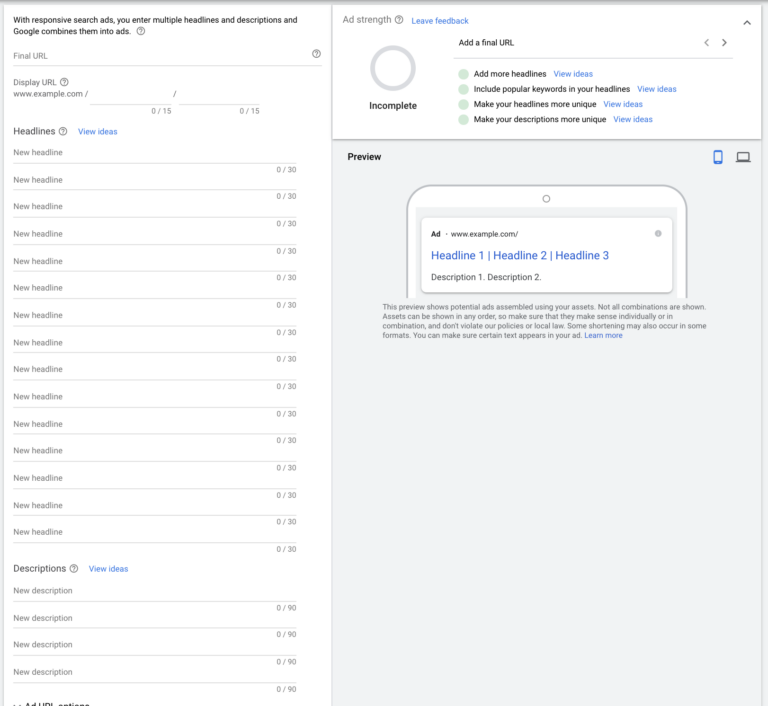
Abby Webb
Head of Search & Content
Abby heads up our SEO and content campaigns, with a strong background in copywriting, content and paid search marketing.

If you’re currently running Google Ads, or you’re planning to give them a go, here are the latest announcements you need to know.
We’re not even a quarter of the way through 2021 yet, and there are already a couple of significant changes Google has made to Google Ads. If you’re currently running ads for your business, or you’re planning to give them a go, here are the latest Google Ads announcements you need to know.
In February, Google announced changes to two of the four keyword match types available in Google Search Campaigns, to simplify the keyword match choices available for advertisers. The changes will affect phrase match and broad match modifiers.
As a reminder, broad match modifiers act like a phase match and broad match hybrid, as your ads are only shown in searches that include the words you place a plus sign in front of.
Essentially, phrase match will start behaving in a similar way to broad match modifiers, while broad match modifiers will be phased out altogether in July 2021.
To give you more control and better reach, we’re bringing the best of broad match modifier into phrase match. As a result, phrase match will expand to cover additional broad match modifier traffic, while continuing to respect word order when it’s important to the meaning.
Google, February 2021
What do you need to do?
When you’re adding new keywords that you would have used broad match modifiers on, Google is now recommending that you try their improved phrase match type instead, because this type now has broad match modifier’s ability to respect the word order within your keywords.
You won’t need to make any changes if you currently use broad match modifiers in your campaigns, as any affected keywords in your account will begin to behave as if they are the new phrase match type. Just remember that from July, you won’t be able to create new keywords using broad match modifiers, so you may want to reconsider your keyword strategy to be prepared for these changes.
How will these changes impact control over keywords?
Many advertisers are wary of the changes to match type. I have some reservations too. Last year, Google reduced the visibility in the Search Terms report, meaning that we could no longer see all the search queries that triggered our ads to show, even if they were clicked on or led to a conversion. Although there are some workarounds to seeing this type of information, it’s still a huge loss of control when trying to optimise your accounts for the best performance.
It’s ironic that Google has stated the latest change to keywords gives advertisers “more control and better reach”, when in many cases, this merging of match types will make it more difficult to control the specific terms you want to appear for.
My advice is to keep checking in on your Search Term report (what you can see of it!) to see if there are any drastic changes to the types of terms you’re showing up for, then try using exact match on the keywords you’re concerned about.
Google is also encouraging advertisers to try responsive search ads (RSA) in their Search Campaigns, as they’ve now become the default ad type that you can create in Google Ads.
What is a responsive search ad?
A responsive search ad automatically adapts to show more relevant headlines and messages when it is displayed in the search results. When you set them up, you’ll enter multiple headlines and descriptions and Google Ads will use its AI learning to choose which combinations to show in the results page.
Before February, the default ad type was the expanded text ad, which is where you supply 3 headlines and 2 lines of description to create 1 static text ad.
Many businesses are reporting better results from their responsive search ads compared to expanded text ads, but there are a few common pitfalls with the format that you should be aware of.
How to create a responsive search ad
When you set up a responsive search ad, you’ll enter multiple headlines and descriptions, from which Google will choose which combinations to show in the search results. You can add up to 15 headlines and 4 lines of description for Google to choose from.

It can be tempting to write headlines that are similar to each other, but our advice is to take your time to create ad assets that are unique from each other. If you supply near-identical headlines and descriptions, you could end up with Google showing repetitive messages that don’t make the most of the valuable ad space that’s available.
So, when entering your headlines and descriptions, make sure you include a broad variety of phrases to avoid repetition.
Throughout the ad creation process, Google will guide you to help you create ad assets that have a variety of meanings and messaging. Just be sure to use your common sense to read through each asset as well, considering how they’ll work with all the other headlines and descriptions in all sorts of combinations.
And make use of all the headlines and description lines available to you. After all, the more content you provide, the more Google can test!
Can you still create expanded text ads?
You can still create expanded text ads, although they are a little more difficult to find. To create one, first click the ‘+’ icon in your Ad Group to create a new ad, choose ‘Responsive search ad’ and then the ‘Switch back to text ads’ link, which is at the top of the page.

If you’ve never given responsive search ads a go, it’s definitely worth adding at least one to each Ad Group to test their performance compared with other ad types available. Google’s machine learning is always improving, and these improvements are being reflected in the features that they are promoting. Always keep at least 1 expanded text ad in each ad group to test your responsive search ads against. Which type will perform better? Let’s find out!
Struggling with your ad performance? Check out 18 of the most common PPC mistakes and how to fix them. Or, if you’re not sure how much you should be spending on your Google Ads, take a look at our PPC budget infographic, which breaks down the average costs by industry.
Our Search team have extensive experience running successful ad campaigns for clients across a range of sectors, and have the skills to transform your account from costly to converting. For more help with running your Google Ads, get in touch with us.

Head of Search & Content
Abby heads up our SEO and content campaigns, with a strong background in copywriting, content and paid search marketing.
View my other articles and opinion pieces below
Google’s AI search demands higher standards for YMYL content. Learn how to keep your financial, legal or health advice visible, trusted and compliant.

At Google Marketing Live 2025, the focus was clear: AI is already changing the way people search, and as a result, it’s changing what brands need to do to show up in search results. Here’s what you need to know – and what it means for your marketing.

Love it or hate it, everyone’s seen it. Google’s AI Overviews are changing the way your search results appear. Now, AI-generated summaries will often answer user questions before the usual list of site links we’ve come to expect. In fact, 47% of Google Search results now include an AI Overview – at least, according to AI […]

This short guide will teach you how to track your marketing campaigns using UTM parameters. Also referred to as a custom URL, a UTM tag is a customised snippet of text (called a parameter) that is added at the end of a website address. This UTM tag allows you to track and identify the traffic […]
